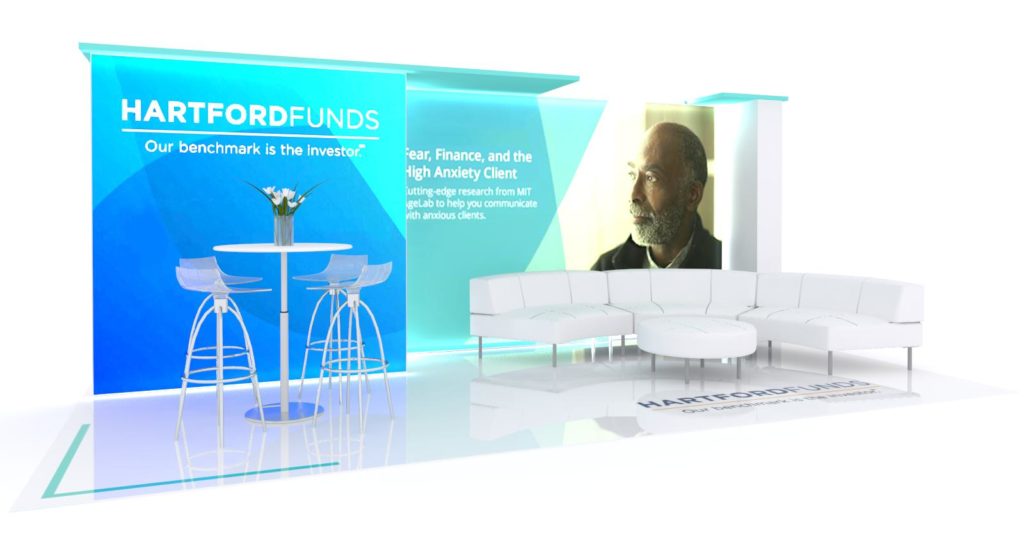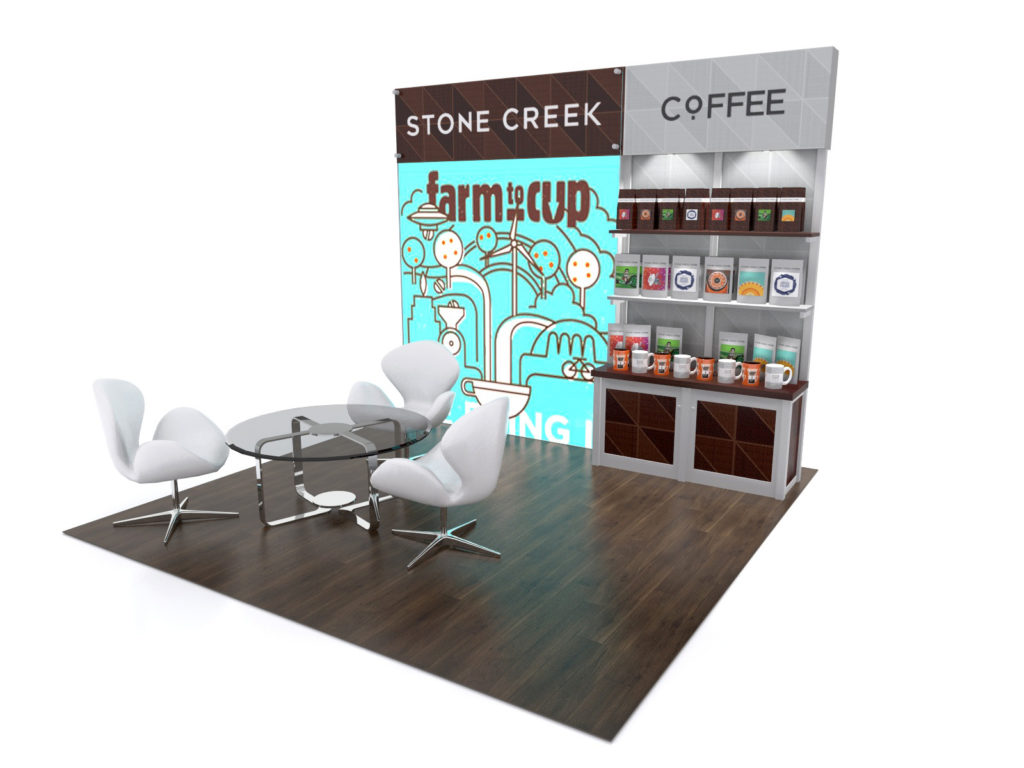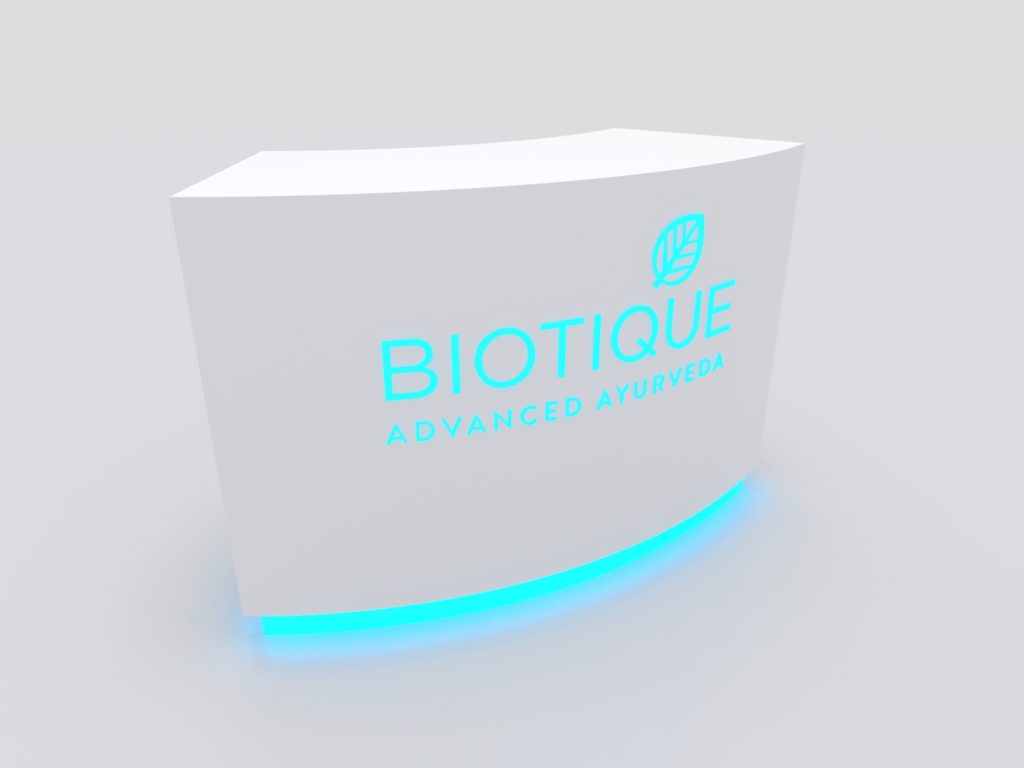Whether you’re in the market for a custom trade show display or considering trade show rentals, it’s imperative to discuss lighting. When we talk about trade show lighting, we often have to get more specific about the types of light than people do in regular life. This is a subject that lighting technicians are familiar with but in which many of the rest of us could use a primer.
Types of Trade Show Lighting
There are three broad categories of lighting, whatever the application: warm; cool; daylight. They’re measured in degrees Kelvin (K). The spread goes from 1,000K to 10,000K. Counter-intuitively, warm light has the lowest Kelvin temperature, and daylight (the “coolest”) has the highest.
Each has its uses in trade show lighting. Below is a quick, high-level introduction to when to use which.
Warm Light (2,000K – 3,000K)
For overall, nonspecific booth illumination, warm light is often the best bet. Just think of the dim lights at a romantic restaurant – they create a cozy atmosphere without making you squint to see.
Red is about the warmest and softest option available for trade show lighting. As the color cools (and gains more degrees Kelvin), yellow will make its way in, changing red to orange. Towards the end of this category, around 3,000K, the orange will turn to yellow, and the yellow will brighten to a whitish color.
Cool Light (3,000K – 4,500K)
Cooler trade show lighting is better for highlighting specific items. It’s also good for lighting up a workspace so you can see everything you’re doing. Thus, the kitchen in that romantic restaurant will have light that’s more like this.
You can create a sense of depth in your lighting by mixing warm lights with cool. That is, you can direct people’s attention to specific spots by illuminating them with brighter, whiter, cooler light, similar to photography.
Daylight (4,500K – 6,500K)
This area of the spectrum is referred to as daylight because it’s the closest to the way sunshine appears to us at noon on a cloudless day. This light is bright white, perhaps with a hint of blue. It’s crisp, casting stark shadows and showing plenty of detail. This will be your most specifically focused trade show lighting, bringing out the nuances of whatever you want people to notice the most.
If all that information seems a little techy to you, just remember that most trade show lighting solutions already have pre-determined temperatures depending on the purpose. For example, puck or downlighting is often cool or daylight to spotlight a product or graphic, but you can always choose a warm light for a softer effect.

Trade Show Lighting Options
The placement, type, and quality of lights can dramatically affect your exhibit or event space. Luckily, there are plenty of choices. The evolution and improvement in LED lights have made a significant impact to trade show lighting in general. Exhibits and booth spaces are brighter, and the lighting is much more consistent. Not so long ago, exhibitors would be forced to mix and match fluorescent, incandescent, halogen, and LED lights. All with different temperatures. Before we do a dive into lighting and lighting design, here’s a list of some of the more common lighting options:
Arm Lights or Stem Lights
These deliver high-quality, wall-washing illumination or spotlighting to desired areas. Mostly used for portable displays or to target a graphic message. These are usually attached with clamps.
Recessed Lights
Recessed lights provide indirect lighting and are ideal for illuminating cases, cabinets, workstations, and undersides of headers.
Puck Lights
Puck lights come in a variety of sizes and spreads and are perfect for downlighting on a product or a message. They are typically attached to the booth to make setup easier.
Track Lights
Like puck lights, track lights are designed to spotlight a product or area. Since they can be easily repositioned, they allow greater flexibility.
Backlighting
Backlighting, specifically backlighting fabric graphics with LED lights, has transformed exhibit design. These lights are available in a variety of sizes, spreads, and temperatures. Most exhibit manufacturers attach them to the frames to make assembly easier and to minimize damage.
Important Considerations for Trade Show Booth Lighting
With the exception of basic banner stands or vinyl backdrops, ALL DISPLAYS should have some form of lighting. It can be as simple as stem lights or as dramatic as backlit graphics. Trade show attendees are more likely to walk into a booth space that’s bright and colorful, rather than dark and gray.
However, lighting adds cost. That includes not only the actual lighting fixtures but also the cost of electrical services at a show. And in some cases, the expense of hiring an electrician on show site. Whether you need an electrician depends on the show hall regulations. It’s important to read the show book carefully. The last thing you want is to scramble to hire electrical services and labor during setup. Those services are allocated in advance and having to wait until someone is available almost always adds cost to your setup.
Know your amps. It sounds complicated but it’s really not. You will order your electricity (and electrical drops) from the General Show Contractor (GSC). The GSC needs to know how many amps your devices will require. LED lights require very few amps, whereas LED video panels or monitors require more. You don’t want to order too little (which can create multiple problems) or order too much (then you’re paying for what you don’t need). Consult with your trade show provider or the GSC to calculate the load. Even little things like phone chargers, tablets, and lead retrieval devices need to be considered.

Incorporating Show Lights and Display Lights in Your Exhibits
First, remember that you’re always in charge of your lighting decisions, and in almost all situations, more lighting can be added by tweaking a design. But it’s important to make those decisions during the design phase; otherwise, lighting modifications may create structural or visual compromises. Lights require wires (although there are a few battery solutions) and those wires eventually go to a power source. Exhibit designers and builders are masters at hiding those wires in portable, modular, and custom exhibits if they know about them in advance.
Secondly, while your show may be in Las Vegas, your booth doesn’t have to have the same lighting overload as The Strip. Not every graphic, counter, workstation, or table has to have a lighting effect. It’s all about the right amount and your overall messaging.
Trade Show LED Lighting and More
Backlit fabric graphics with LED lights are the most common lighting option. These come in single and double-sided frames. Sizes vary from small 24 x 24-inch accent lightboxes to massive towers and canopies. There are differences between exhibit suppliers, but those are more often than not quality-related. Yes, like everything else, there are good and bad lightboxes.
Backlit fabric graphics with programmable LED lights while less common, programmable LED lights can be mesmerizing. These lights are programmed to create movement in the graphic like a waterfall or a rocket launching.
Counters, workstations, and tables with LED perimeter accent lights. LED light strips make adding soft perimeter lighting to accessories easy and inexpensive. It can be as simple as a white light, as colorful as adding RGB programmable lighting (red, green, blue, etc), or as dynamic as motion and the sequencing of colors.
Backlit lettering or logos. A backlit or edge-lit logo can be the difference between a ho-hum exhibit and an exhibit that gets compliments.
Downlighting using puck lights or stem lights. Like “peas and carrots” as Forrest Gump would say. Downlighting is indispensable for nearly every exhibit whether a portable 10 ft. display or a 50 x 50 custom island.
Other Lighting Solutions. It’s really endless. The same light fixtures used in homes, businesses, and retail showrooms can be used in a trade show exhibit. Consider hanging pendant lights if you have a bar or seating area in your booth. Or wall-mounted lights to highlight a guest speaker. Or even floor lamps in meeting rooms. Nothing is off-limits as long as it’s certified and safe.
Experiment. Be Creative. Just because it’s not “standard” doesn’t mean it’s not possible. LED lights and lighting design are moving targets. A few years ago, a backlit hanging sign was an engineering nightmare. Now, not so much. As the saying goes, “if you can dream it,” there’s a good chance your exhibit provider can design and build it. Be imaginative!
Trade Show Lighting Examples
The VKN-2984 demonstrates the dramatic impact of large lightboxes, vibrant fabric graphics, and custom construction. There are two lightboxes in this design: (1) 86” x 92” and (1) 136” x 92”. Both are illuminated with LED light modules attached to the perimeter of lightweight extrusion frames. The LED modules have a typical life of 50,000 hours. That’s a lot of trade shows!
The VKN-1353 uses a lightbox and downlighting for a sophisticated yet practical 10 x 10 exhibit. There’s 72” x 96” LED lightbox with fabric graphics along with a laminated/plex backlight header for the company’s logo and messaging. Next to the lightbox are shelves for products, illuminated with recessed LED spotlights. This design illustrates that effective lighting isn’t just for larger exhibits.

The MODN-1584 counter is a visual upgrade to any booth. The backlit logo and perimeter toe kick lighting transform a custom reception counter into a welcoming entrance. The LED perimeter lights are programmable RGB so they can be adjusted to any color and enhanced with movement (flashing, fading, transitioning from one color to another color).

Biggest Takeaways About Tradeshow Light Options
#1. Let the design dictate the lighting.
#2. Choose the right lighting temperature
#3. LED lights have expanded your choices.
#4. Remember to check the show book from the GSC for what is and isn’t allowed.
#5. There’s so much more to lighting than simply illuminating your graphics.
#6. Be imaginative. It’s your booth.
The Three Tiers of Trade Show Lighting
This is just a start. There is much more to say about trade show lighting than the scope of this article allows but maybe now, when you walk around your next trade show and look at other companies’ booths, you’ll be able to say to yourself, “They should have used warmer light here and cooler there.” Have fun thinking about how you can improve your trade show lighting!
Schedule a call with our team at Exhibits Northwest and we’ll work hard to make your next exhibit light up the show!
